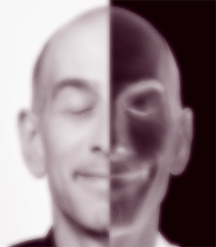Our reliance on the intellect explains in part the inability of humanity to deal effectively with its own delusional identity. Many psychologists use therapeutic techniques that are unnecessarily complicated or unclear in the expression of the principles being applied. We can see this demonstrated in the article by psychologist Miriam Greenspan. Following Greenspan’s comments, I will “bold” related Simple Reality principles to illustrate the distinction between how the P-B intellect explains reality compared to the intuitive insights found in P-A. We are going to transcend pop psychology, erroneous Jungian constructs and the fallacies of the human intellect to the “uncommon sense” of our inner wisdom.
First we can engage the popular if poorly understood behavior often called “positive thinking.” The author makes a good point that always striving to be positive can be a form of denial. “At … times putting on a happy face merely spreads a thin patina over our hidden sorrows….As a culture, we see the dark emotions as symptoms of impairment and pathology rather than as the darker colors of our rich emotional palette. We call them “negative.” But it’s not really the emotions that are negative—it’s our attitude toward them.”
More accurately, in Simple Reality (P-A), it’s our beliefs about emotions that are the problem. All emotions are afflictive, that is to say, all emotions are reactions and result in suffering even those we mistakenly believe to be “pleasurable.” Therefore, the solution is to not identify with our emotions and to not react to our conditioning associated with our emotions. Instead we can choose to breathe and respond thereby experiencing the “feeling” of being in the present moment having transcended the craving and aversion that are the source of all human self-destructive behavior and the source of most human emotions. It is not just our attitude about our emotions but also our beliefs and values related to them that are also problematic.
“While we think of fear as an obstacle to action, it’s just the opposite: fear alerts us to threat and impels us to act to preserve life….When we don’t honor the dark emotions, we end up experiencing their powerful energies in displaced, irrational and destructive forms. We become addicted to alcohol, drugs, sex, shopping or the Internet. We get chronically depressed, anxious and phobic, emotionally numb. We’re more prone to self-destructive or violent behavior.”
Fear has its genesis in the values, beliefs, and attitudes of P-B. We can choose to express the energy of fear as a reaction which will be based on our illusory identity associated with believing that we are our body, mind or emotions and that the fear and our false self are in fact “real.” If we choose to cease identifying with that false self, take the time to remain in the present moment, the dark specter of fear will eventually collapse like the Wicked Witch of the West into a pile of rags floating in a puddle of water. The mirage of our imagined fears will be revealed.
“Emotional mindfulness is essential to emotional alchemy, the process by which the lead of our worst feelings can be transmuted to the gold of spiritual power and wisdom.”
Emotional mindfulness is a contradiction in terms. Mindfulness involves not expressing any kind of emotion which would be, by definition, a reaction, which generates suffering. The very definition of mindfulness (Vipassana or Insight) meditation first taught by Buddha includes “responding” thereby experiencing the “feeling” of the present moment by choosing not to react or not to identify with the body, mind or emotions as if they were our real identity. Practicing mindfulness mediation will eventually lead to the Great Insight of Oneness (Simple Reality) which will result in a new self-reliant identity able to choose response over reaction, ultimately transcending common neuroses and suffering.
In describing the treatment of her client, Diane, Greenspan reveals important insights of her own as well as misunderstandings about the nature of reality. “From then on, Diane’s therapy consisted largely of grief and despair work for her lost marriage. She saw herself in a dark underground tunnel. With my encouragement, she gave herself permission to get to know the tunnel rather than to claw her way out prematurely.”
All pain, whether it’s the emergence of repressed shadow content or survival strategy conditioning, can be effectively treated the same way. Greenspan is right in that we don’t want to flee into the distraction of addictive behaviors but rather remain in the present and breathe until we are able to respond. A person who is not clinically ill need not wait to begin using The Point of Power Practice thereby experiencing immediate results in overcoming fear and gaining control over the reactions caused by afflictive emotions however long that may take.
If today’s psychiatrists and therapists would ground their practice in the context of Oneness, teaching mindfulness meditation to support a new and self-reliant identity, then they would more often have the result of behavioral modification and indeed behavioral transformation. The Point of Power Practice would be a natural outgrowth of such a paradigm shift. This is the direction that psychology needs to go if we are ever to experience the possibility of a sustainable human community.
References and notes are available for this essay.
Find a much more in-depth discussion in books by Roy Charles Henry:
Where Am I? The First Great Question Concerning the Nature of Reality
Simple Reality: The Key to Serenity and Survival



